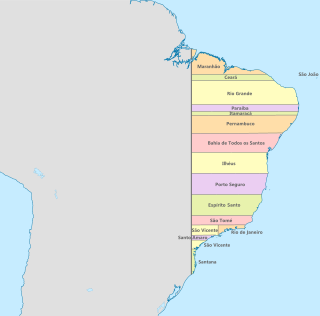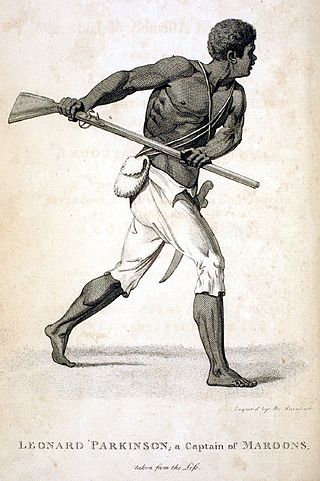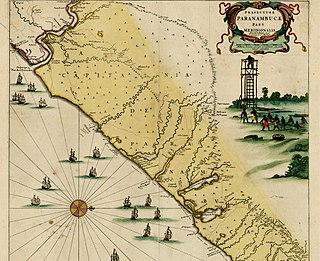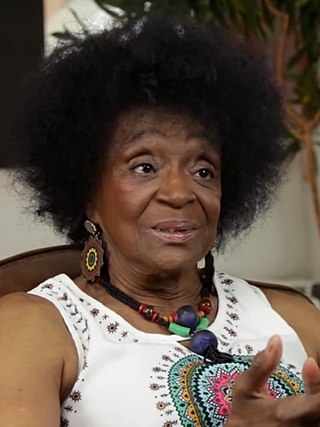
Colonial Brazil comprises the period from 1500, with the arrival of the Portuguese, until 1815, when Brazil was elevated to a kingdom in union with Portugal. During the 300 years of Brazilian colonial history, the main economic activities of the territory were based first on brazilwood extraction, which gave the territory its name; sugar production ; and finally on gold and diamond mining. Slaves, especially those brought from Africa, provided most of the workforce of the Brazilian export economy after a brief initial period of Indigenous slavery to cut brazilwood.

A quilombo ; from the Kimbundu and Kikongo word kilombo, lit. 'war camp') is a Brazilian hinterland settlement founded by people of African origin, and others sometimes called Carabali. Most of the inhabitants of quilombos, called quilombolas, were maroons, a term for escaped slaves.

Battle of Mbwila occurred on 29 October 1665 in which Portuguese forces defeated the forces of the Kingdom of Kongo and decapitated king António I of Kongo, also called Nvita a Nkanga.

Zumbi, also known as Zumbi dos Palmares, was a Brazilian quilombola leader and one of the pioneers of resistance to enslavement of Africans by the Portuguese in colonial Brazil. He was also the last of the kings of the Quilombo dos Palmares, a settlement of Afro-Brazilian people who liberated themselves from enslavement in the present-day state of Alagoas, Brazil. He is revered in Afro-Brazilian culture as a symbol of African freedom.

Maroons are descendants of Africans in the Americas and Islands of the Indian Ocean who escaped from slavery, through flight or manumission, and formed their own settlements. They often mixed with Indigenous peoples, eventually evolving into separate creole cultures such as the Garifuna and the Mascogos.

Palmares, or Quilombo dos Palmares, was a quilombo, a community of escaped slaves and others, in colonial Brazil that developed from 1605 until its suppression in 1694. It was located in the captaincy of Pernambuco, in what is today the Brazilian state of Alagoas. The quilombo was located in what is now the municipality of União dos Palmares.
Nganga Nzumba was the first leader of the massive runaway slave settlement of Quilombo dos Palmares, or Angola Janga, in the present-day state of Alagoas, Brazil. Zumba was enslaved and escaped bondage on a sugar plantation and eventually rose to the position of highest authority within the kingdom of Palmares, and the corresponding title of Ganga Zumba.

União dos Palmares is a municipality located in the Brazilian state of Alagoas. Its population was 65,790 (2020) and its area is 428 km². Surrounding agricultural land is largely dedicated to sugar cane and cattle. At one time, when the city was an active rail stop with regular passenger service, it was named simply União due to its rail junction joining Alagoas and Pernambuco. The name was changed in 1944 to reflect its historic significance. The city is increasingly seeing domestic and foreign tourist drawn by historical and natural features that are now protected in Parque Nacional Serra da Barriga and Parque Memorial Quilombo dos Palmares.

The military history of Brazil comprises centuries of armed actions in the territory encompassing modern Brazil, and the role of the Brazilian Armed Forces in conflicts and peacekeeping worldwide. For several hundreds of years, the area was the site of intertribal wars of indigenous peoples. Beginning in the 16th century, the arrival of Portuguese explorers led to conflicts with the indigenous peoples; a notable example being the revolt of the Tamoio Confederation. Sporadic revolts of African slaves also marked the colonial period, with a notable rebellion led by Zumbi dos Palmares. Conflicts were fought with other European nations as well – two notable examples being the France Antarctique affair, and a conflict with the Netherlands in the early 17th century over control of much of Northeastern Brazil. Although Portugal retained its possessions during conflicts with other nations, it lost control of the colony after the Brazilian war of Independence, which led to the establishment of the Empire of Brazil.
The mocambos were village-sized communities mainly of runaway slaves in colonial Brazil, during Portuguese rule.
Dandara was an Afro-Brazilian warrior of the colonial period of Brazil and was part of the Quilombo dos Palmares, a settlement of Afro-Brazilian people who freed themselves from enslavement, in the present-day state of Alagoas. After being arrested on February 6, 1694, she committed suicide, refusing to return to a life of slavery. She is a mysterious figure today, because not much is known about her life. Most of the stories about her are varied and disconnected. She and her husband Zumbi dos Palmares, the last king of the Quilombo dos Palmares, had three children.

A quilombola is an Afro-Brazilian resident of quilombo settlements first established by escaped slaves in Brazil. They are the descendants of Afro-Brazilian slaves who escaped from slave plantations that existed in Brazil until abolition in 1888. The most famous quilombola was Zumbi and the most famous quilombo was Palmares. Many quilombolas live in poverty.

Léa Lucas Garcia de Aguiar was a Brazilian actress. She was known for her numerous television and film roles. Her breakout role was in the 1959 Oscar-winning Black Orpheus, in which she portrayed Serafina, Eurydice's cousin.

Brazil is in South America

Quilombo is a 1984 Brazilian drama film directed by Carlos Diegues. It was entered into the 1984 Cannes Film Festival. The film is based on the history of the Quilombo dos Palmares, a community of escaped slaves that numbered in the thousands during the 17th century in north-eastern Brazil.

Slavery in Latin America was an economic and social institution that existed in Latin America before the colonial era until its legal abolition in the newly independent states during the 19th century. However, it continued illegally in some regions into the 20th century. Slavery in Latin America began in the pre-colonial period when indigenous civilizations, including the Maya and Aztec, enslaved captives taken in war. After the conquest of Latin America by the Spanish and Portuguese, of the nearly 12 million slaves that were shipped across the Atlantic, over 4 million enslaved Africans were brought to Latin America. Roughly 3.5 million of those slaves were brought to Brazil.
Aqualtune was a Kongo princess who was the daughter of an unidentified Manikongo. According to the tradition, she was the mother of Ganga Zumba and the maternal grandmother of Zumbi.

Cerca do Macaco, also called "Cerca Real dos Macacos" or just "Macaco", was a historical settlement located on the peak of the Serra da Barriga in the state of Alagoas, Brazil. It was the main settlement of the Palmares, an established group of fugitives and escaped slaves.

The history from the Brazilian state of Alagoas begins before the discovery of Brazil by the Portuguese, when the territory was inhabited by the Caeté people. The coast of the current state of Alagoas, recognized since the first Portuguese expeditions, was also visited early on by vessels of other nationalities for the barter of brazilwood.














